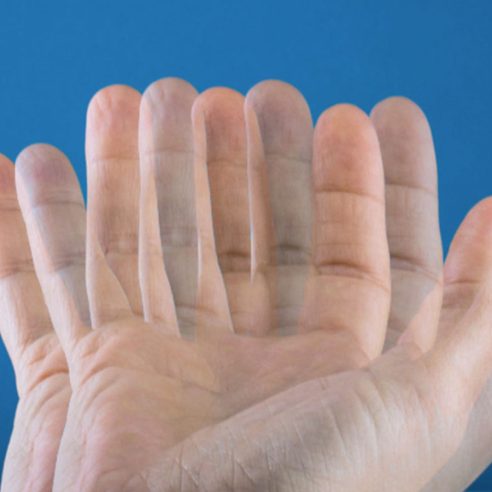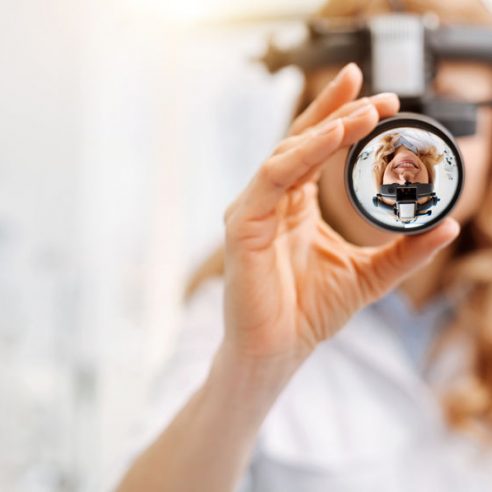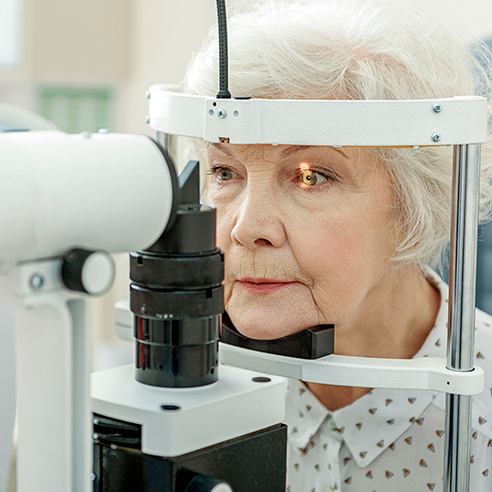Amblyopia or "lazy eye" in adults and children
Amblyopia is a vision problem, popularly known as “lazy eye”. This disorder can occur in one or both eyes, and studies show that around 3% of the population suffer from this eye disease.
It occurs at a young age and is manifested by reduced visual acuity in the affected eye. The “lazy eye” retina is under-stimulated during the critical period of vision development, so that the affected eye cannot provide full clarity. Symptoms are not obvious, so regular examinations are recommended, both for adults and especially for children.
What causes amblyopia?
Amblyopia can have several causes.
- The most common is the difference in the quality of the images created by the two eyes. This happens when amblyopia affects only one eye. The “lazy eye” will form a less clear image, while the “healthy” eye will form a clear image. Over time, the brain will choose to remove the less clear image, causing the eye to become amblyopic.
- Strabismus is another cause of amblyopia. Lack of parallelism of the two ocular axes causes one eye to move in the right direction and the other in the wrong direction. The brain will choose to rely more on the normally functioning eye, leading to amblyopia in the other eye.
- Various refractive errors – myopia, hypermetropia, astigmatism or presbyopia – can be causes of amblyopia. The eye with the lower refractive error tends to take up vision, while the eye with the higher refractive error is not used and becomes amblyopic.
Congenital cataract, congenital palpebral ptosis, congenital glaucoma and corneal damage are some of the organic eye problems that can cause amblyopia.
What do you need to know about amblyopia in children?
One of the most common ophthalmological disorders in children is amblyopia. Figures show that around 2-4% of children up to the age of 15 suffer from this disorder. Amblyopia in children often starts at birth and progresses until they are 7 years old. Usually only one eye is affected, but there are also rare cases where both eyes become amblyopic.
There are certain risk factors that increase the risk of young children suffering from lazy eye:
- The child has a family history of eye disease;
- The child was born premature, with a low birth weight;
- The child has developmental problems.
In this respect, ophthalmological evaluation is essential up to the age of 3 (and beyond). The earlier it is detected, the easier it is to treat amblyopia in children. Therefore, if you notice that your child’s eyes are not coordinating properly, pay a visit to an ophthalmology clinic, address the problem early, when the complex connections between the eyes and the brain are not yet fully formed.
What do you need to know about amblyopia in adults?
There is a general view that amblyopia in adults cannot be treated. Nothing could be further from the truth. Advances in research and cutting-edge ophthalmologic technologies make it possible to treat amblyopia in adults. Once the type of disease is diagnosed, amblyopia in adults can be corrected optically, through glasses, computer vision therapy or surgery. The latter are designed to restore vision where adult amblyopia is caused by strabismus, convergence insufficiency and anisometropia.
How many types of amblyopia are there?
Amblyopia can be:
- Functional: only one eye is affected.
- Bilateral: both eyes are affected and one eye is more amblyopic than the other. This type occurs in patients with refractive errors, strabismus or nystagmus.
- Organic: occurs in the context of more severe ophthalmic diseases such as cataracts, retinopathy, retinal detachment, corneal opacity.
What are the symptoms of amblyopia?
Amblyopia in adults and children can be seen if:
- An eye does not seem to stare, but “wanders” inwards or outwards;
- The eyes do not move at the same time, in the same direction;
- The eyes are not able to see clearly, in depth;
- The patient cannot close or close one eye at a time;
- The patient tends to tilt the head to focus with the healthy eye;
- The patient is missing – partially or totally – the iris (suffering from aniridia);
- Following investigation and visual screening, results are abnormal.
How is amblyopia treated?
The first step in treating the ophthalmological disorder is to diagnose the type of amblyopia. To do this, it is essential to know the family history and to carry out ocular tests to determine the cause of the disease. The chances of restoring visual acuity to the “lazy eye(s)” are very high when the disorder is diagnosed very early – that means before the age of 3.
There are several forms of treatment for amblyopia, depending on the form of the disease and the age of the patient:
Treatment is mainly non-surgical and may involve:
- Wearing of occlusal glasses or contact lenses;
- Application of eye drops;
- Covering the good eye or alternately both eyes, depending on the situation, to get the patient to use their “lazy eye”;
- It cannot be operated on, but by the age of 7-10 years, it can be corrected. With the VTS (Vision Therapy System), the best system currently available, a recovery of over 90% can be achieved.
- The treatment sessions are similar to a computer game, so that they are easy for the little ones to use. The therapy consists of training the lazy eye to see smaller details and improving hand-eye coordination, spatial distance estimation and contrast sensitivity.
Not treating amblyopia affects the quality of vision in the long term. If you notice any of the above symptoms in yourself, or someone close to you, make an appointment at a specialist clinic. Dr. Holhos Ophthalmology Network is waiting for you with professional doctors and state-of-the-art industry equipment for the best care.
Text medically reviewed by Dr. Teodor Holhoș, Ophthalmic Surgeon
Written by
Dr. Holhos Team Diseases
Nystagmus is the eye condition where the eyes make repetitive and uncontrollable movements. Discover other symptoms and treatment options.
Color vision deficiency, also known as dyschromatopsia, is a general term referring to various vision disorders characterized by a deficiency in color perception.
“Flying flies” are most often harmless and represent a normal stage in the aging process. Find out what the causes are and how you can reduce the symptoms.
Ocular allergies occur as a reaction of the body to an allergen, causing inflammation and itching in the eyes. The most common ocular allergies are seasonal.
Ophthalmic migraine is most common in the 40s. It manifests itself in visual impairment and even temporary blindness.
Keratitis, also known as “corneal ulcer”, is an inflammation of the cornea. If detected early, the ophthalmological disorder is easy to treat and heals quickly.
Diplopia is an ophthalmological disease in which you see two images of the same thing. The condition can affect anyone, but is more common after the age of 60.
Xanthelasma is a member of the xanthomas family and represents fatty deposits in the skin cells around the eyes. It is visible as yellow, harmless bumps.
Colorblind people perceive colors differently from most people. Most of the time, this ophthalmological disorder makes it difficult to distinguish between certain colors.
Epiphora is an ophthalmological disorder manifested by excessive tearing of the eyes. Most of the time, it is not severe and disappears on its own. However, if you are experiencing this and the problem persists, we recommend that you make an appointment for an ophthalmological examination. Treatment can be different, depending on the cause of the epiphora.
If you notice a yellow spot on the white of your eye, you are most likely dealing with pinguecula. The ophthalmological disorder is not severe, but the symptoms can be uncomfortable. Find out how to treat pinguecula and, more importantly, how you can prevent it.
Entropion is the ophthalmological disorder in which the eyelid of the eye turns inwards. It is different from ectropion, where the eyelid turns outwards. It most often occurs in older people and usually only affects the lower eyelid.
It is possible that you may also be experiencing ocular toxoplasmosis without knowing it. This retinal disorder is extremely common in our century and is manifested by eye discomfort and blurred vision.
Ectropion is the ophthalmic disorder in which the eyelid and eyelashes pull away from the cornea, and reorient outwards.
One of the most common types of headache is headache of ocular origin. It occurs as a result of an ophthalmological disorder.
Blepharitis is an ophthalmological disorder that manifests itself by inflammation of the eyelids. At the base of the eyelids, the patient notices small crusts formed by solidified oil particles or bacteria that collect in the crease at the corner of the eye.
Uveitis is an ophthalmological disorder of the uveal tract, manifested by changes in vision and eye pain.
Among the most common ophthalmological disorders is hordeolum. This is popularly known as an “stye” and is an infection of the eyelids.
The drooping eyelid is known in medical terms as “palpebral ptosis”. It manifests itself by narrowing the visual slit of one or both eyes, creating aesthetic and functional discomfort.
Amblyopia is a vision problem, popularly known as “lazy eye”. This disorder can occur in one or both eyes, and studies show that around 3% of the population suffer from this eye disease.
The sensation of “dry eyes” or “tired eyes” is known in medical terms as “dry keratoconjunctivitis” or “xerophthalmia”, and refers to a dysfunction of the tear film.
Strabismus, also known as “crossed-eyes” or “crossed vision”, is an ophthalmological disorder in which the visual axis of the eyes is not aligned. This causes one eye to deviate when it needs to look at a fixed point.
Conjunctivitis is one of the most common ophthalmological disorders. It can occur in adults, children and babies.
Chalazion is manifested by inflammation of the upper or lower eyelid. It is one of the most common ophthalmological disorders, and occurs when the secretion of sebaceous glands in the eye is blocked.
Macular degeneration involves deterioration of the macula and therefore of the quality of central vision. This disease does not affect peripheral vision and therefore cannot lead to complete blindness.
Hypermetropia affects the ability to see nearby objects. You may be able to see distant objects clearly, but closer objects, even words in a book, are usually out of focus. Hypermetropia occurs when the eye does not focus light properly on the retina (the light-sensitive layer at the back of the eye).
Myopia is a disorder that falls into the category of refractive errors (along with astigmatism and hypermetropia). In common terms, myopia manifests itself as blurred distance vision, while near vision is not a problem.
Astigmatism, like myopia and hypermetropia, is a refractive error. In general terms, the disorder manifests itself in blurred, fuzzy vision, regardless of the distance to objects, surfaces.
Presbyopia is an age-related disorder characterized by decreased near vision. It usually appears around the age of 40.
Cataract is a common ophthalmological disorder that causes progressive loss of vision through loss of lens transparency. Studies show that about 50% of the population loses their vision due to this disorder.
Cataract is a fairly common eye disorder that causes a progressive loss of vision due to loss of lens transparency.
Diabetic retinopathy is a complication of diabetes that manifests itself at the eyes level, caused by high blood sugar levels and damage to the blood vessels of the light-sensitive tissue at the back of the eye (retina).
The retina is the light-sensitive layer deep inside the eyeball, lining the back of the eye. It is a piece of neural tissue that creates a focused two-dimensional image that is translated into a neural electrical impulse that translates the image to create visual perception.
Epiretinal membrane is a disorder of the interface area between the posterior vitreous and the central area of the retina, the macula.
The vitreous body is located in the center of the eyeball, between the lens and the retina, and appears as a “gel”. A healthy vitreous is completely transparent allowing light to reach the retina without any problems, thus obtaining a clear vision.
Glaucoma is a chronic, bilateral eye disease characterized by progressive destruction of the fibers of the optic nerve, the nerve responsible for transmitting information from the eye to the brain.
Keratoconus is a degenerative disease that manifests itself by progressive deformation and thinning of the cornea. It usually appears in adolescence, affects both men and women, and progresses into adulthood.






































